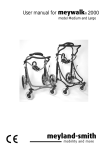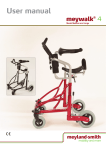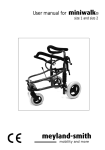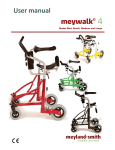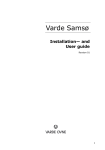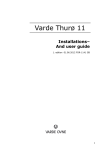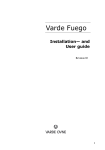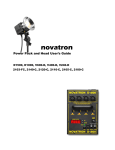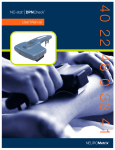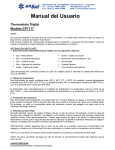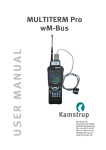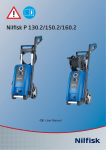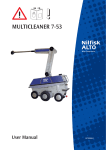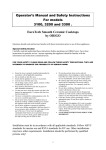Download Meywalk MK3
Transcript
User manual model medium and large meyland-smith mobility and more www.meyland-smith.dk Tel: +45 98 96 19 85 Dear customer, This user manual contains information on the assembly and adjustment of Meywalk® mk3, how to maintain it, things to watch out for, and other important items. Before you start using Meywalk® mk3, we recommend that you read this user manual. If you have any questions regarding Meywalk® mk3, please contact us. CONTENTS: Introduction................................................................................ Meywalk® mk3 parts................................................................. Prior to first use......................................................................... Joining the top part and bottom frame....................................... Spring loading........................................................................... Standard adjustment – step by step.......................................... Handlebar.................................................................................. Tubes......................................................................................... Seat........................................................................................... Seat position and angle............................................................. Rear stop................................................................................... Trunk support............................................................................ Trunk support replacement........................................................ Trunk support tilting................................................................... Getting in and out...................................................................... Brakes....................................................................................... Accessories: Anti-tip supports........................................................................ Dragbrakes................................................................................ Non-reverse brakes................................................................... Swivel locks............................................................................... Leg divider................................................................................. Leg guides................................................................................. Tray............................................................................................ Cleaning and maintenance........................................................ Safety precautions..................................................................... Technical data........................................................................... page 2 Page 2 Page 3 Page 4 Page 4 Page 4 Page 5 Page 5 Page 5 Page 6 Page 6 Page 6 Page 7 Page 7 Page 7 Page 8 Page 8 Page 9 Page 10 Page 11 Page 12 Page 13 Page 14 Page 15 Page 17 Page 17 Page 19 www.meyland-smith.dk Tel: +45 98 96 19 85 Meywalk® mk3 models Medium and Large are primarily designed for walking disabled children, young people and adults who have difficulty standing up without support. Meywalk® mk3 is designed for indoor use. Meywalk® mk3 is a walking aid suitable for children. Parts of Meywalk® mk3: 1 2 1: Trunk support 2: Handlebar 3: Handlebar spanner grips 3 4 4: Thumb screw for adjustment of trunk support height 5: Thumb screw for adjustment of tilt function 6: Thumb screw for adjustment of seat height 5 6 7: Seat with reat stop 7 8 9 8: Spanner grip for adjustment of upper tube 9: Upper tube with spring 10: Lower tube 11 11: Tilt bar 10 14 12: Fender wheel 13: Front wheel 14: Brake 12 15: Rear wheel 13 Figure 1 With Meywalk® mk3 you have acquired one of the best walking aids on the market, just as the materials are of a very high quality. ∙ ∙ ∙ ∙ ∙ ∙ Meywalk® mk3 follows individual body movements and walking patterns. Helps the user keep his/her torso upright and makes the user feel safe. The handlebar supports the user’s arms and reduces the strain on them. The seat can be lowered when getting in and out. The rear stop helps keep the user comfortably seated. The integrated springs support the walking function. page 3 15 www.meyland-smith.dk Tel: +45 98 96 19 85 Prior to first use Meywalk® mk3 is supplied almost fully assembled. Check that the package contains the following parts: Bottom frame with wheels and brakes, Top part with seat and trunk support. Note! Three Allen keys of 4 mm, 5 mm and 6 mm are included in the Meywalk® mk3 supply. They are located under the seat bar (see figure 2). Figure Figur 2 2 Joining the top part and bottom frame Place the top part in the tubes on the bottom frame (see figure 3) – note that the two springs must be placed at the top of the bottom frame (see figure 3). Lower the top part into the two tubes on the bottom frame. Remember to position the top part so that the handle bar points in the direction of the swivelling front wheels. Figure Figur 3 3 Spring loading The two springs inside the tubes (see figure 4) can be changed to obtain harder or softer suspension. As a guideline, the weight of the user must be able to fully compress the springs. There are four different spring hardness levels corresponding to the following body weight: White springs for minimum 20 kg Yellow springs for minimum 45 kg Blue springs for minimum 65 kg Red springs for minimum 80 kg. page 4 Figure Figur 4 4 www.meyland-smith.dk Tel: +45 98 96 19 85 Adjustment of Meywalk® mk3 - step by step It is always a good idea to consult our consultant before adjustment of Meywalk® mk3. Tubes NB! Do not carry out this adjustment while a user is placed in Meywalk® mk3. First roughly adjust the height of Meywalk® mk3. The height is adjusted by lifting the lower spanner grip in the green arrow’s direction. Simultaneously rotate the upper spanner grip (see figure 5). Note that when the upper spanner grip has been rotated a bit, the lower spanner grip no longer needs to be lifted. To ensure that the tube engages the lower spanner grips is pressed slightly downwards. The tube will engage after two rotations. Model Medium features 7 holes in total and model Large features 8 at intervals of approx. 2.5 cm between each hole. Medium can be lifted a total of approx. 18 cm and Large a total of approx. 20 cm. If Meywalk® mk3 is to be lifted, rotate the spanner grip towards the green arrow and if it is to be lowered, rotate towards the red arrow. Make sure that both sides are equally high; count the holes (see figure 6). Rule of thumb: The correct height has been achieved when the user’s elbows are abreast of the handlebar spanner grips (see figure 7). Figure Figur 5 5 Figur 66 Figure Handlebar The handlebar is connected to two spanner grips (see figure 7). When turned in the green arrow’s direction, the spanner grips will open and the handlebar can rotate. When the desired handlebar angle has been found, retighten the spanner grips by rotating them in the red arrow’s direction until the points are fully closed. NB! Make sure that the user cannot hurt his/her head on the raised part of the handlebar. page 5 Figure Figur 77 www.meyland-smith.dk Tel: +45 98 96 19 85 Seat NB! Do not carry out this adjustment while a user is placed in Meywalk® mk3. Adjust the seat height according to the length of the user’s legs. Turn the lower thumb screw located at the front of Meywalk® mk3 (see figure 8). The thumb screw features a “child lock” which is released according to the press-andturn principle. When released, the seat can be adjusted up or down. Position the seat at the correct height. Hold your hand under the seat bar bottom to make the seat slide easily up and down. Retighten the thumb screw when the desired height is reached. Figure Figur 8 8 Seat position and angle NB! Do not carry out this adjustment while a user is placed in Meywalk® mk3. The seat can be adjusted forwards and backwards on the bar by loosening the Allen screw on the seat fitting below (see figure 9). When the desired position has been found, retighten the Allen screw. The angle of the seat can be adjusted by loosening the four nuts under the seat fitting (see figure 10). Use an 11 mm spanner. Retighten the nuts after adjustment. The seat is also completely removable. Figure Figur 9 9 Rear stop The rear stop should always be tilted back when there is a user in Meywalk® mk3. The rear stop can be put down by pressing the small block until it is clear of the fitting. Then the rear stop slides in under the seat. Figur 1010 Figure Rear stop adjustment The rear stop behind the seat can be adjusted lengthways depending on the position of the seat. Before adjustment, put down the rear stop by lifting up the rear stop so that the small block goes clear of its position. Now the rear stop can be pushed in under the seat. From the end you can now see an Allen screw inside the square profile (see figure 11). The longitudinal direction can be adjusted by means of this screw. Remember to retighten the Allen screw. page 6 Figure Figur 1111 www.meyland-smith.dk Tel: +45 98 96 19 85 Trunk support Adjust the trunk support according to the individual user’s optimal height. Turn the upper thumb screw located at the front of the Meywalk® mk3 central tube (see figure 12). The thumb screw features a so-called “child lock”, working according to the press-and-turn principle. When released, the trunk support can be adjusted up and down until the correct height has been found. Retighten the thumb screw. Figure1212 Figur Trunk support replacement NB! Do not carry out this adjustment while a user is placed in Meywalk® mk3. For trunk support replacement, loosen the two Allen screws under the support. The two screws fits all trunk supports. The trunk support is available in five variants: Circumference: 70, 90, 105,120 and 130 cm. Tilt function NB! Do not carry out this adjustment while a user is placed in Meywalk® mk3. By means of the tilt function the user’s posture can be changed. Turn the middle thumb screw to the left to tilt the support. The screw is located at the front of Meywalk® mk3 (see figure 14). While turning the screw, you can change the angle of the trunk support and of the seat up to 14°. The tilt function is continuously adjustable (see figures 15 and 16). Figure1313 Figur Figure 14 Figure 16 Figur 16 Figure Figur 1515 page 7 www.meyland-smith.dk Tel: +45 98 96 19 85 Getting in and out Featuring a unique lifting and lowering system Meywalk® mk3 has made it easier for the user to get in and out. Grab the front of the tilt bar with both hands and tip it up, then the seat will be lowered approx.13 cm for Medium and 22 cm for Large (see figure 17). When the user has been seated, close the trunk support and pull up the rear stop. The seat is lifted by pushing down the tilt bar until it locks with an audible click (see figure 18). The integrated gearing in the lifting and lowering system means that the downward pressure need only be about one third of the user’s weight. Figure Figur 1717 Brakes The brakes are parking brakes that work by directly blocking the rear wheels with a braking pulley pressing against the tyre. To brake the walking aid, pull the brake levers all the way backwards until they come to a definite stop (see figure 19). In this position the brakes are self-locking. The brakes are released by pushing the brake levers forward again. Figur 1818 Figure Figur 1919 Figure page 8 www.meyland-smith.dk Tel: +45 98 96 19 85 Meywalk® mk3 accessories The accessories are attached to the frame as indicated in the illustration: 1: Anti-tip supports 7 2: Drag brakes 3: Non-reverse brakes 4: Swivel locks 5: Leg divider 6: Leg guides 5 7: Tray 4 1 6 2 3 Figure 20 Mounting and adjustment of accessories Anti-tip supports Anti-tip supports are mounted on each side by first removing one of the two bolts fixing the wheel. Use a 6 mm Allen key. Place anti-tip supports against the outside of the Meywalk® mk3 rear fork so that they fall into place in the two rear fork recesses. Screw bolts back on from either side. Remember to tighten firmly. page 9 www.meyland-smith.dk Tel: +45 98 96 19 85 Drag brakes The drag brakes are mounted inside the existing brake housing. First loosen the brakes by pushing the brake levers forward. Then loosen the four screws fixing the brake housing to the bottom frame (see figure 21) by means of a 4 mm Allen key. Lift up the entire brake mechanism. Remove the upper plastic plug. Now mount the drag brake. Insert the pin in the hole on the brake housing side and place the drag brake in the brake housing ensuring that the pin goes through the drag brake (see figure 22). Mount the small spacer and drive the pin through the brake housing completely. Re-mount the brake housing using the four screws. Then screw the Allen screw with nut into the thread on the upper side of the braking housing (see figure 23). Screw and nut help adjust the drag brake pressure against the tyre. The drag brakes work by the roller at the back pressing against the tyre. First loosen the nut on the Allen screw. Then turn the Allen screw to press the roller against the tyre. Tighten the nut in the opposite direction. Use a method of trial and error to find the correct pressure against the tyre. Test the drag brake function. Figure 21 Figure 22 Figure 23 page 10 www.meyland-smith.dk Tel: +45 98 96 19 85 Non-reverse brakes The non-reverse brakes are also mounted inside the existing brake housing. First loosen the brake by pushing the brake levers forward. Then loosen the four screws fixing the brake housing to the bottom frame (see figure 21) using a 4 mm Allen key. Lift up the entire brake mechanism and remove the square plastic plug. Insert the pin in the hole on the outside of the brake housing and place the non-reverse brake and the spacer or drag brake (if this is used) so that the pin goes through both (see figure 24). Put the brake housing back and re-tighten the four screws. Remove the round black plug and fit the snap lock in the hole (see figure 25). The non-reverse brake works by the grooved side pressing against the tyre preventing the wheel from going backwards. The non-reverse brake can be engaged/disengaged through the snap lock on the upper side of the brake housing. Finally test the function of the non-reverse brake. page 11 Figure2424 Figur Figure 25 www.meyland-smith.dk Tel: +45 98 96 19 85 Swivel locks The swivel locks are fastened to the frame of Meywalk® mk3 directly behind the front wheels. First make sure that the snap lock is completely fastened to the nut on the mounting plate, if necessary use a monkey wrench for tightening it. Pull back the top of the snap lock and turn it 90° - the lock is now deactivated. Each of the two mounting plates (with snap locks) is now fastened to the underside of the triangular part of the frame, which holds the front wheel (see figure 26). The mounting plate is turned so that the nut faces down and is placed so the hole in the mounting plate fits the hole in the triangular part of the frame (the mounting plate for the right-hand lock is inclined to the right when the snap lock points straight forward and reversed for the lefthand lock). In this position the small knob on the upside of the mounting plate can be fitted into a hole on the triangle underneath the fender of the wheel. When the mounting plate is placed correctly it is fastened with the bolt from above, through first the triangle and secondly the mounting plate. The hole in the mounting plate has an inside thread so the bolt can be screwed in with a 6 mm Allen key (see figure 27). The front swivel wheel is locked by pulling back the snap lock and turning it 90°. page 12 Figure 26 Figure 27 www.meyland-smith.dk Tel: +45 98 96 19 85 Leg divider The leg divider is mounted on the curved tube under the saddle of Meywalk® mk3. The leg divider is mounted by loosening and removing the Allen screw on the side of the bent mounting plate. It is now possible to place the mounting plate around the curved tube under the saddle. The leg divider is turned so the center tube is in front (see figure 28). The Allen screw is put through one side of the mounting plate, through the two tightening rings and is screwed into the thread on the other side of the mounting plate. Please note that the two tightening rings must be vertical and the cylindrical rods must touch the sides of the mounting plate (see figure 29). Before the leg divider is fastened completely it can be adjusted back and forth on the curved tube to fit the step length of the user. The two divider sheets can be vertically repositioned by loosening the Allen screw placed on the front of the center tube (see figure 30). It is possible to change the width of the leg divider with plastic distance sheets. The large plastic divider sheets are taken off and a distance sheet is placed between the divider sheet and the steel plate (on which the divider sheets are mounted). A distance sheet increases the width by 6 mm and it is possible to place distance sheets on both or only one side. WARNING: Please make sure that the leg divider doesn’t collide with the floor when the tilt bar is raised (when the user is getting in and out of Meywalk® mk3). page 13 Figure 28 Figure 29 Figure 30 www.meyland-smith.dk Tel: +45 98 96 19 85 Leg guides The leg guides shield the feet of the user from the wheels of the walking aid ensuring that the user’s foot is not by accident caught under one of the wheels. With the unique suspension brackets the leg guides will lift over small objects and doorsteps. The leg guides are mounted on the inside of the lower frame by the brake unit (referred to as point 1) and the tube holding the tilt bar (referred to as point 2) - see figure 31. First loosen the screws at the two mounting points with a 5 mm Allen key - at point 2 the extra key is used to stop the screw on the outside from turning. The mounting frame is turned so the highest vertical bar is in front and the plates are positioned toward the middle of Meywalk® mk3 (see figure 32). The screw at point 1 is replaced by an M6x16 screw and at point 2 the threaded rod and flat head bolt is replaced by the supplied ones, which are longer. The mounting frame is fastened at each of the two points. point 1 Figure 31 Figure 32 This is repeated at the opposite side and the leg guides are ready for use. Figure 33 page 14 point 2 www.meyland-smith.dk Tel: +45 98 96 19 85 Tray The tray is fastened to the handlebar of Meywalk® mk3. It is placed below the handlebar and is held by the two bent mountings along with the two tube mountings. The tube mountings are fixed with the two supplied bolts to the underside of the handlebar. This is most easily done by opening the two spanner grips for the handlebar and turning the handlebar so it rests on the trunk support. The two bolts on the underside can be unscrewed and the handlebar can be taken off (see figure 35). Pull the two tube mountings onto the ends of the handlebar. The mountings are turned so the small catch is placed furthest from the end of the handlebar and placed so the hole in the mounting fits the hole on the underside of the handlebar. When the handlebar is put back on the walker the bolts are screwed in through the mountings, the foam and into the handlebar (see figure 36). Therefore small holes in the foam must be made to fit the hole in the handlebar. The handlebar is turned to horisontal position (in front of the walker) and the tray can be put on the handlebar. The two bent mountings are pressed onto the handlebar while making sure that the tray rests on the catches of the tube mountings (see figure 37). The tray has a thin foil fixed to the top of it. Photos etc. can be put between tray and foil to inspire and amuse the user of the walker. To place photos lift the foil in the small flap that is bent upwards (see figure 37). Tube mountings Bent mountings Figure 34 Figure 35 Figure 36 WARNING: Do not lift the foil above an angle of 45° to the tray, since that will pose a risk of damaging the foil. Do not squeeze the foil in sharp folds since it may not be possible to straighten them again. Do not place the tray so it is strained by the thumb screws of Meywalk® mk3. page 15 Figure 37 www.meyland-smith.dk Tel: +45 98 96 19 85 page 16 www.meyland-smith.dk Tel: +45 98 96 19 85 Cleaning and maintenance of Meywalk® mk3 Maintenance The walking aid can be washed in warm water with detergent but take care not to wash the padding on the trunk support, handle bar and rear stop. With time the painted frame may take on a matt appearance if washed with detergent repeatedly. If so, the frame can be polished with car polish. Follow the instructions on the polish. Re-tightening Regularly check the tightness of all grips, bolt, screws and nuts, and re-tighten if required. Safety precautions Warning: • Meywalk® mk3 is a therapy product and should only be used as such! • The spring system of Meywalk® mk3 may involve a risk of the walking aid toppling over if used by a very restless user. • Meywalk® mk3 rolls very easily and you should always consider potential dangers that the user may roll over to. Therefore: Never leave the user in Meywalk® mk3 unattended! Warning: • Always hold the tilt bar securely when a user is being lifted or lowered. Especially when opening the tilt bar to lower the user, you must be prepared for the upward force which gradually increases as the tilt bar rises (see figure 38). Never let go of the tilt bar in the middle of a lifting or lowering operation, even if taken by surprise by the heavy weight loading. Big force Little force Figure 38 Warning: • If fittings are removed, open tube ends may be revealed. These may have sharp inner edges and may be dangerous for probing fingers. However, MEYWALK® mk3 is designed to avoid open ends! If a situation with open tube ends should nevertheless arise, it is recommended that they be closed off with plastic plugs. Warning: Polyurethane and foam tubes are not to be consumed. Limitations on use • The maximum user weight permitted is 100 kg. • The walking aid should only be used on flat, level and stable surfaces. page 17 Figure 39 page 18 Trunk support height Inner leg length www.meyland-smith.dk Tel: +45 98 96 19 85 www.meyland-smith.dk Tel: +45 98 96 19 85 Technical data Dimensions: Length: External width: Internal width: Seat height / inner leg length: Trunk support height: Trunk support options: (chest circumference) Medium: 85 cm 62 cm 47 cm 50 - 70 cm 90 - 115 cm 70 cm, 90 cm, 105 cm 120 cm, 130 cm Large: 101 cm 69 cm 54 cm 70 - 95 cm 109 - 140 cm 70 cm, 90 cm, 105 cm 120 cm, 130 cm 30,5 kg 100 kg 33,5 kg 100 kg Weight: Meywalk® mk3, without accessories: Max. load: Materials: Frame: Fittings: Padding: Wheels: Colour: Powder-coated steel tubes Matt-finish chromium plated steel Polyurethane foam Soft solid rubber tyres on plastic rims with service-free ball bearings Red metallic or Blue metallic CE markning Meywalk® mk3 is CE marked. This guarantees that Meywalk® mk3 is in compliance with all relevant safety requirements specified in Council Directive 93/42/EEC on medical devices. Meywalk® mk3 is tested by Berlin Cert, Prüf- und Zertifizierstelle für Medizinprodukte GmbH, an der Technischen Universität Berlin. page 19 Dealer: Manufacturer: Meyland-Smith a/s Industrivej 27, DK - 9830 Taars Tel: +45 98 96 19 85 Fax: +45 98 96 19 86 [email protected] www.meyland-smith.dk Rev: MØC 300407




















